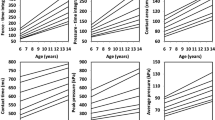Abstract
OBJECTIVE: This study examined the effects of obesity on static and dynamic plantar pressure distributions displayed by children.
DESIGN: Field-based experimental data on body mass index (BMI) and plantar pressures were collected for 10 obese children and 10 nonobese controls.
SUBJECTS: In all, 10 obese (age 8.8±2.0 y, BMI 25.8±3.8 kg m−2) children matched to 10 nonobese children (age 8.9±2.1 y, BMI 16.8±2.0 kg m−2), for gender, age and height.
MEASUREMENTS: Height and weight were measured to calculate BMI. Right and left foot plantar pressures were obtained using an AT-4 emed® pressure platform (Novelgmbh, Munich) to calculate the peak force and pressure experienced under areas of each child's feet during static and dynamic conditions.
RESULTS: While standing, the obese children generated significantly higher forces over a larger foot area and experienced significantly higher plantar pressures compared to their nonobese counterparts (41.8±17.7; 30.1±12.0 N cm−2, respectively; P<0.022). Similarly, while walking, the obese children generated significantly higher forces over all areas of their feet, except the toes. Despite distributing these higher forces over a significantly larger foot area when walking, the obese children experienced significantly higher plantar pressures in the midfoot (P<0.003) and under the second to fifth metatarsal heads (P<0.006) compared to the nonobese children.
CONCLUSIONS: It is postulated that obese children are at an increased risk of developing foot discomfort and/or foot pathologies due to increased plantar loads being borne by the small forefoot bones. Furthermore, continual bearing of excessive mass by children appears to flatten the medial midfoot region during walking. As the long-term consequences of these increased plantar loads are currently unknown, it is recommended that the effects of obesity on the structural and functional characteristics of obese children's feet be further investigated.
This is a preview of subscription content, access via your institution
Access options
Subscribe to this journal
Receive 12 print issues and online access
$259.00 per year
only $21.58 per issue
Buy this article
- Purchase on Springer Link
- Instant access to full article PDF
Prices may be subject to local taxes which are calculated during checkout



Similar content being viewed by others
References
Novelgmbh. Novel-win (Version 08.7). Novel gmbh: Munich, Germany; 1998.
Mann RA . Biomechanics of running. American Academy of Orthopaedic Surgeons Symposium on the foot and leg in running sports. CV Mosby Company: St Louis; 1982. pp 30–44.
Cavanagh PR, Rodgers MM, Iiboshi A . Pressure distribution under symptom-free feet during barefoot standing. Foot Ankle 1987; 7: 262–276.
Gehlsen GM, Seger A . Selected measures of angular displacement, strength, and flexibility in subjects with and without shin splints. Res Q Exerc Sport 1980; 51: 478–485.
Viitasalo JT, Kvist M . Some biomechanical aspects of the foot and ankle in athletes with and without shin splints. Am J Sports Med 1983; 11: 125–130.
Messier SP, Pittala KA . Etiologic factors associated with selected running injuries. Med Sci Sports Exerc 1988; 20: 501–505.
Messier SP, Davies AB, Moore DT, Davis SE, Pack RJ, Kazmar SC . Severe obesity: effects on foot mechanics during walking. Foot Ankle Int 1994; 15: 29–34.
Riddiford-Harland DL, Steele JR, Storlien LH . Does obesity influence foot structure in prepubescent children? Int J Obes Relat Metab Disord 2000; 24: 541–544.
Dowling AM, Steele JR, Baur LA . Does obesity influence foot structure and plantar pressures in prepubescent children? Int J Obes Relat Metab Disord 2001; 25: 845–852.
David AC, Manfio EF, Mota CB, Avila AOV . Temporal parameters and plantar pressure distribution in normal-weight and obese children 1999. Paper presented at the 17th International Society of Biomechanics Congress, Calgary, Canada.
Cole TJ, Bellizzi MC, Flegal KM, Dietz WH . Establishing a standard definition for child overweight and obesity worldwide: international survey. BMJ 2000; 320: 1240–1243.
Hills AP, Hennig EM, McDonald M, Bar-Or O . Plantar pressure differences between obese and non-obese adults: a biomechanical analysis. Int J Obes Relat Metab Disord 2001; 25: 1674–1679.
Bryant A, Singer K, Tinley P . Comparison of the reliability of plantar pressure measurements using the two-step and midgait methods of data collection. Foot Ankle Int 1999; 20: 646–650.
Meyers-Rice B, Sugars L, McPoil T, Cornwall MW . Comparison of three methods for obtaining plantar pressures in nonpathological subjects. J Am Podiatr Med Assoc 1994; 84: 499–504.
Cavanagh PR, Ulbrecht JS . Clinical plantar pressure measurement in diabetes: rationale and methodology. Foot 1994; 4: 123–135.
Hennig EM, Staats A, Rosenbaum D . Plantar pressure distribution patterns of young school children in comparison to adults. Foot Ankle Int 1994; 15: 35–40.
Fuller E, Computerised Gait Evaluation In: Valmassy RL (ed). Clinical biomechanics of the lower extremities 1996. CV Mosby: New York, 179–205.
Kosiak M . Etiology and pathology of ischemic ulcers. Arch Phys Med Rehabil 1959; 42: 62–69.
Drerup B, Kraneburg S, Koller A . (2000, 2–6 August, 2000). Visualisation of pressure dose: synopsis of peak pressure, mean pressure, loading time and pressure–time integral 2000. Paper presented at the emed Scientific Millenium Meeting, Munich, Germany.
Author information
Authors and Affiliations
Corresponding author
Rights and permissions
About this article
Cite this article
Dowling, A., Steele, J. & Baur, L. What are the effects of obesity in children on plantar pressure distributions?. Int J Obes 28, 1514–1519 (2004). https://doi.org/10.1038/sj.ijo.0802729
Received:
Revised:
Accepted:
Published:
Issue Date:
DOI: https://doi.org/10.1038/sj.ijo.0802729
Keywords
This article is cited by
-
The effect of orthotics on plantar pressure in children with infantile tibia vara (Blount's disease)
Scientific Reports (2023)
-
Foot morphology as a predictor of hallux valgus development in children
Scientific Reports (2023)
-
Standard reference values of weight and maximum pressure distribution in healthy adults aged 18–65 years in Germany
Journal of Physiological Anthropology (2020)
-
Foot–Ground Interaction during Standing in Individuals with Down Syndrome: a Longitudinal Retrospective Study
Journal of Developmental and Physical Disabilities (2016)
-
Musculoskeletal pain in overweight and obese children
International Journal of Obesity (2014)



